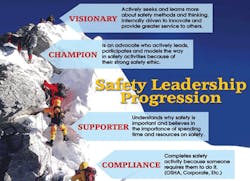Most companies regard employee safety as a core value with significant economic benefits, among them increased productivity, reduced absenteeism and workers' compensation costs and improved employee attraction and retention. According to a report from the American Society of Safety Engineers, "Having a solid safety and health management program with senior-management commitment will improve productivity and employee morale."
It has been estimated that U.S. companies spend upwards of $170 billion a year on direct and indirect costs associated with workplace injuries and illnesses. Yet efforts to improve safety based solely on economics are destined to fall short of the objective of zero work-related injuries. In fact, such efforts inevitably reach a point where investing in safety no longer makes economic sense. Achieving safety perfection requires a deeply held personal belief in the value of people, the opinion that one injury is one too many and the concern that the next injury could be your own son or daughter.
Since its inception in 2002, EnPro Industries continuously has improved its safety performance, having twice been named one of America's Safest Companies by EHS Today. In the process of establishing our own culture of safety and helping others with theirs, we have come to realize that internally driven leadership and employees' public affirmation of their commitment to safety are critical to the success of a safety culture.
The hierarchy of safety leadership descends from visionary or transformational safety leaders at the top, down to those who seek to learn more about safety and are driven to innovate and serve others, to those who are concerned with achieving compliance, to those who conduct safety activities to meet the requirements of their employer or some external agency such as OSHA.
Between the extremes of visionary leaders and those who only are interested in meeting requirements are champions and supporters. Champions, or advocates, actively lead safety activities because of their own strong safety ethic, modeling the way for a corporate safety ethic and inspiring others. A notch below champions are supporters, those who understand safety is important and believe in spending time and resources on it.
Becoming Visionary
We were champions at EnPro, but recognized that we had to achieve the visionary level of safety leadership if we were to be successful in establishing a true, corporate-wide culture of safety. We also realized that to achieve that level, we would have to gain deep insights into human behavior, such as what drives people to put themselves at risk.
Dealing with the cultural and behavioral aspects of safety has proven to be the most difficult part of the process. We needed to understand and transcend these potential obstacles to creating a culture of safety.
"One thing all managers know is that many of the best ideas never get put into practice," wrote Peter Senge, director of the Center for Organizational Learning at the MIT Sloan School of Management, in The Fifth Discipline, The Art & Practice of the Learning Organization. "Brilliant strategies fail to get translated into action. Systemic insights never find their way into operating policies. A pilot experiment may probe to everyone's satisfaction that a new approach leads to better results, but widespread adoption of the approach never occurs."
Senge goes on to explain why the "better idea" often never sees the light of day: " … New insights fail to get put into practice because they conflict with deeply held internal images of how the world works, images that limit us to familiar ways of thinking and acting."
Developing Safety Leadership
It requires effective leadership to break though the mental models and organizational inertia to which Senge refers. In developing this leadership, we had to identify the attributes of a good leader, and resolve the age-old question of whether leaders are born or made.
Are leaders that exhibit these behaviors born or made? The best estimate offered by research is that leadership is about one-third innate and two-thirds developed. There appear to be people with inborn characteristics that predispose them to becoming leaders. However, in my experience, safety leaders/advocates are made. They achieve safety success regardless of the business they're in, the position they hold, their geographic location, the age of their facility or whether they're union or non-union.
At EnPro, using a concept called "Safety – My Voice," we encourage employees to think about and discuss how they feel about safety. Most people care about it, but to what degree? When asked, their thoughts and feelings manifest themselves in different ways, often in terms of personal experiences with colleagues, family or others. The more you talk about it, the more fully developed your thoughts about safety become, evolving up the leadership hierarchy from compliance, to supporter, to champion and ultimately, to visionary.
We ask employees to set their own commitment level within this hierarchy, with those interested in compliance saying, "Safety is equally as important as quality and production," and the supporter saying, "Safety is more important than anything we do, more important even than quality and production."
The champion is dedicated to and personally involved in creating an injury-free workplace. The visionary, however, looks at the bigger picture and says, "We strive to be the world's safest employees, recognizing that all injuries can be prevented both at work and at home."
Because talking about it is the surest way to accelerate safety awareness and commitment, we practice "Safety – My Voice" on a regular basis. Safety discussions have continued for as long as an hour at management meetings; if you're passionate about something you can go on about it.
We also encourage our employees to inspect and challenge their mental models about safety by personalizing, visualizing and communicating to them the benefit of safety to themselves and their fellow employees.
Safety is not a once-and-done proposition, but a continuous striving toward perfection. That's why at the beginning of each year, every EnPro employee makes a public and personal commitment to safety by signing a pledge that reads, "I pledge to personally be involved to create an injury-free workplace. My dedication to creating a safe workplace free of all injuries will be absolute and clear through my actions."
Learning how you feel about the safety of your fellow employees – or for that matter, members of your own family – calls for regular inspection of your mental models about the degree of risk you are willing to take yourself and for others. Even if your company's injury rate is well-below the average for your industry, you must not accept that one of your fellow workers will be one of the unfortunate few to get injured.
Visionary safety leadership constantly seeks to take the culture to the next level and challenge our perceptions of what is acceptable. In short, we aim at nothing short of perfection.
Joe Wheatley is the corporate director of risk management and EHS Affairs for EnPro Industries Inc. of Charlotte, N.C.

